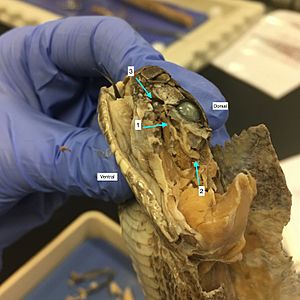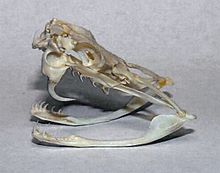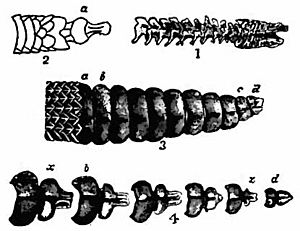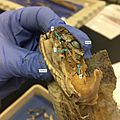Rattlesnake facts for kids
Quick facts for kids Rattlesnake |
|
|---|---|
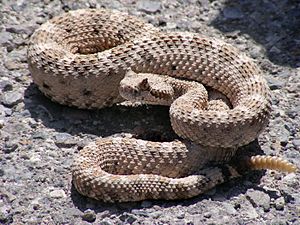 |
|
| Crotalus cerastes | |
| Scientific classification | |
| Kingdom: | |
| Phylum: | |
| Class: | |
| Order: | |
| Suborder: | |
| Family: | |
| Subfamily: | |
| Genera | |
Rattlesnakes are a group of venomous snakes of the genera Crotalus and Sistrurus of the subfamily Crotalinae (the pit vipers). The scientific name Crotalus is derived from the Greek κρόταλον, meaning "castanet". The name Sistrurus is the Latinized form of the Greek word for "tail rattler" (Σείστρουρος, seistrouros) and shares its root with the ancient Egyptian musical instrument the sistrum, a type of rattle. The 36 known species of rattlesnakes have between 65 and 70 subspecies, all native to the Americas, ranging from southern Alberta, Saskatchewan, and southern British Columbia in Canada to central Argentina.
Rattlesnakes are predators that live in a wide array of habitats, hunting small animals such as birds and rodents.
Rattlesnakes receive their name from the rattle located at the end of their tails, which makes a loud rattling noise when vibrated that deters predators or serves as a warning to passers-by. However, rattlesnakes fall prey to hawks, weasels, king snakes, and a variety of other species. Rattlesnakes are heavily preyed upon as neonates, while they are still weak and immature. Large numbers of rattlesnakes are killed by humans. Rattlesnake populations in many areas are severely threatened by habitat destruction, poaching, and extermination campaigns.
Rattlesnakes are the leading contributor to snakebite injuries in North America. However, rattlesnakes rarely bite unless provoked or threatened; if treated promptly, the bites are seldom fatal.
Contents
Ecology
Range and habitat
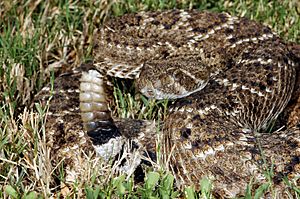
Rattlesnakes are native to the Americas, living in diverse habitats from southwestern Canada to central Argentina. The large majority of species lives in the American Southwest and Mexico. Four species may be found east of the Mississippi River, and two in South America. In the United States, the states with the most types of rattlesnakes are Texas and Arizona.
Rattlesnakes are found in almost every type of habitat capable of supporting terrestrial ectothermic vertebrates, but individual species can have extremely specific habitat requirements, only able to live within certain plant associations in a narrow range of altitudes. Most species live near open, rocky areas. Rocks offer them cover from predators, plentiful prey (e.g. rodents, lizards, insects, etc. that live amidst the rocks), and open basking areas. However, rattlesnakes can also be found in a wide variety of other habitats including prairies, marshes, deserts, and forests. Rattlesnakes prefer a temperature range between 80 and 90°F (26 and 32°C), but can survive temperatures below freezing, recovering from brief exposure to temperatures as low as 4°F (−16°C), and surviving for several days in temperatures as low as 37°F (3°C).
The most probable ancestral area of rattlesnakes is the Sierra Madre Occidental region in Mexico. The most probable vegetation or habitat of the ancestral area appears to be pine-oak forests. Feeding habits play an important ecological role by limiting the size of rodent populations, which prevents crop damage and stabilizes ecosystems.
Prey
Rattlesnakes consume mice, rats, small birds , and other small animals. They lie in wait for their prey, or hunt for it in holes. The prey is killed quickly with a venomous bite as opposed to constriction. If the bitten prey moves away before dying, the rattlesnake can follow it by its scent. When it locates the fallen prey, it checks for signs of life by prodding with its snout, flicking its tongue, and using its sense of smell. Once the prey has become incapacitated, the rattlesnake locates its head by odors emitted from the mouth. The prey is then ingested head-first, which allows wings and limbs to fold at the joints in a manner which minimizes the girth of the meal. The gastric fluids of rattlesnakes are extremely powerful, allowing for the digestion of flesh, as well as bone. Optimal digestion occurs when the snake maintains a body temperature between 80 and 85 °F (25 and 29 °C). If the prey is small, the rattlesnake often continues hunting. If it was an adequate meal, the snake finds a warm, safe location in which to coil up and rest until the prey is digested.
Hydration
Rattlesnakes are believed to require at least their own body weight in water annually to remain hydrated. The method in which they drink depends on the water source. In larger bodies of water (streams, ponds, etc.), they submerge their heads and ingest water by opening and closing their jaws, which sucks in water. If drinking dew, or drinking from small puddles, they sip the liquid either by capillary action or by flattening and flooding their lower jaws.
Predators
Newborn rattlesnakes are heavily preyed upon by a variety of species, including ravens, crows, roadrunners, raccoons, opossums, skunks, coyotes, weasels, whipsnakes, kingsnakes, and racers. Neonates of the smaller crotaline species are frequently killed and eaten by small predatory birds such as jays, kingfishers, and shrikes. Some species of ants in the genus Formica are known to prey upon neonates, and Solenopsis invicta (fire ants) likely do, as well. On occasion, hungry adult rattlesnakes cannibalize neonates. The small proportion (often as few as 20%) of rattlesnakes that make it to their second year are heavily preyed upon by a variety of larger predators including coyotes, eagles, hawks, owls, falcons, feral pigs, badgers, indigo snakes, and kingsnakes.
The common kingsnake (Lampropeltis getula), a constrictor, is immune to the venom of rattlesnakes and other vipers, and rattlesnakes form part of its natural diet. Rattlesnakes sense kingsnakes' presence by their odor. When they realize a kingsnake is nearby, they begin enacting a set of defensive postures known as "body bridging". Unlike its normal erect and coiled defensive-striking posture, the rattlesnake keeps its head low to the ground in an attempt to prevent the kingsnake from gaining a hold on it (the head being the first part of the rattlesnake to be ingested). The rattlesnake jerks its body about, while bridging its back upwards, forming an elevated coil which faces the kingsnake. The elevated coil is used to strike the attacker, and is also used to shield the head from the kingsnake.
Anatomy
Sensory organs
Like all pit vipers, rattlesnakes have two organs that can sense radiation: their eyes, and a set of heat-sensing "pits" on their faces that enable them to locate prey and move towards it, based on the prey's thermal radiation signature. These pits have a relatively short effective range of about 1 ft, but give the rattlesnake a distinctive advantage in hunting for warm-blooded creatures at night.
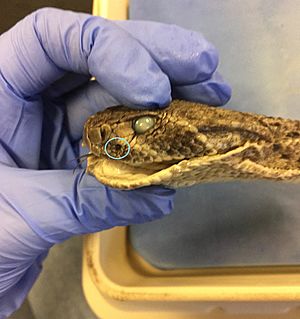
Heat-sensing pits
Aside from their eyes, rattlesnakes are able to detect thermal radiation emitted by warm-blooded organisms in their environment. Functioning optically like a pinhole camera eye, thermal radiation in the form of infrared light passes through the opening of the pit and strikes the pit membrane located in the back wall, warming this part of the organ. Due to the high density of heat-sensitive receptors innervating this membrane, the rattlesnake can detect temperature changes of 0.003 °C or less in its immediate surroundings. Infrared cues from these receptors are transmitted to the brain by the trigeminal nerve, where they are used to create thermal maps of the snake’s surroundings. Due to the small sizes of the pit openings, typically these thermal images are low in resolution and contrast. Nevertheless, rattlesnakes superimpose visual images created from information from the eyes with these thermal images from the pit organs to more accurately visualize their surroundings in low levels of light. Research conducted recently on the molecular mechanism of this ability suggests the temperature sensitivity of these pit organs is closely linked to the activity of transient receptor potential ankyrin 1, a temperature-sensitive ion channel saturated in the pit membrane.
Eyes
Rattlesnake eyes, which contain a large number of rod cells, are well adapted to nocturnal use. However, rattlesnakes are not exclusively nocturnal, and their vision is more acute during daylight conditions. Rattlesnakes also possess cone cells, which means they are capable of some form of color vision. The rattlesnake eye lacks a fovea, making it impossible for them to see sharply defined images. Instead, they mostly rely on the perception of movement. Rattlesnake eyes are capable of horizontal rotation, but they do not appear to move their eyeballs to follow moving objects.
Smell
Rattlesnakes have an exceptionally keen sense of smell. They can sense olfactory stimuli both through their nostrils and by flicking their tongues, which carry scent-bearing particles to the Jacobson's organs in the roof of their mouths.
Auditory system
Like all snakes, rattlesnakes lack external ear openings, and the structures of their middle ear are not as highly specialized as those of other vertebrates, such as mammals. Thus, their sense of hearing is not very effective, but they are capable of sensing vibrations in the ground, passed by the skeleton to the auditory nerve.
Fangs
Rattlesnake fangs are connected by venom ducts to large venom glands near the outer edge of the upper jaw, towards the rear of the head. When the rattlesnake bites, muscles on the sides of the venom glands contract, which squeezes the venom through the ducts and into the fangs. When the fangs are not in use, they remain folded against the palate.
Rattlesnakes are born with fully functioning fangs and venom, and are capable of killing prey at birth. Adult rattlesnakes shed their fangs every 6–10 weeks. At least three pairs of replacement fangs lie behind the functional pair.
Venom
The venom is hemotoxic, destroying tissue, causing necrosis and coagulopathy (disrupted blood clotting).
Rattlesnake venom is a mixture of five to 15 enzymes, various metal ions, biogenic amines, lipids, free amino acids, proteins, and polypeptides. It contains components evolved to immobilize and disable the prey, as well as digestive enzymes which break down tissue to prepare for later ingestion. The venom is very stable, and retains its toxicity for many years in storage.
Older snakes possess more potent venom, and larger snakes are frequently capable of storing larger volumes of it.
Rattle
The rattle serves as a warning for predators of the rattlesnake. The rattle is composed of a series of hollow, interlocked segments made of keratin, which are created by modifying the scales that cover the tip of the tail. The contraction of special "shaker" muscles in the tail causes these segments to vibrate against one another, making the rattling noise (which is amplified because the segments are hollow) in a behavior known as tail vibration. The muscles that cause the rattle to shake are some of the fastest known, firing 50 times per second on average, sustained for up to three hours.
At birth, a “prebutton” is present at the tip of the snake's tail; it is replaced by the “button” several days later when the first skin is shed. However, no sound can be made by the rattle until a second segment is added when the skin is shed again. A new rattle segment is added each time the snake sheds its skin, and the snake may shed its skin several times a year, depending on food supply and growth rate.
Rattlesnakes travel with their rattles held up to protect them from damage, but in spite of this precaution, their day-to-day activities in the wild still cause them to regularly break off end segments. Because of this, the age of a rattlesnake is not related to the number of rattles on its tail.
One of the differentiating features of males and females is the males have thicker and longer tails (because they contain the inverted hemipenes). Also, the tails of males taper gradually from the body, whereas the tails of females narrow abruptly at the vent.
Skin and circulation
Rattlesnakes, like other members of the Squamata order, contain a circulatory system that is powered by a three-chambered heart composed of two atria and one ventricle. The right atrium receives deoxygenated blood from veins coming from the systemic circuit. The left atrium receives oxygenated blood from the lungs in the pulmonary circuit and pumps it to the ventricle and through the systemic circuit via capillaries and arteries.
Rattlesnake skin has a set of overlapping scales which cover the entire body, providing protection from a variety of threats including dehydration and physical trauma. The typical rattlesnake, genus Crotalus, has the top of its head covered with small scales, except, with a few species, a few crowded plates directly over the snout. The skin of snakes is highly sensitive to contact, tension, and pressure; they are capable of feeling pain.
An important function of the skin is the sensation of changes in air temperature, which can guide the snakes towards warm basking/shelter locations. All snakes are ectotherms. To maintain a stable body temperature, they exchange heat with their external environments. Snakes often move into open, sunny areas to absorb heat from the sun and warmed earth, a behavior known as basking. Nerves in the skin regulate the flow of blood into the veins near the surface.
The skin of rattlesnakes is intricately patterned in a manner that camouflages them from their predators. Rattlesnakes do not generally have bright or showy colors (reds, yellows, blues, etc.), instead relying on subtle earth tones that resemble the surrounding environment.
Creases in the epidermal tissue connect the scales of rattlesnakes. When ingesting large prey, these creases can unfold, allowing the skin to expand to envelop a much greater volume. The skin appears to tightly stretch to accommodate the meal, but in reality, the skin is simply smoothing out from its creased state and is not under very high tension.
Reproduction
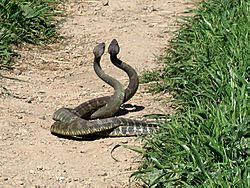
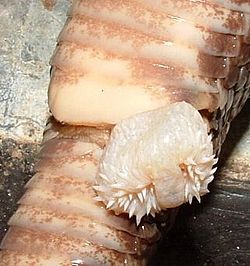
Most rattlesnake species mate during the summer or fall, while some species mate only in the spring, or during both the spring and fall.
Females secrete small amounts of sex pheromones, which leave a trail the males follow using their tongues and Jacobson's organs as guides. Once a receptive female has been located, the male often spends several days following her around (a behavior not common outside of the mating season), frequently touching and rubbing her in an attempt to stimulate her.
The males of some species, such as timber rattlesnakes (C. horridus), fight each other during the mating season, in competition over females. These fights known as "combat dances" consist of the two males intertwining the anterior portion of their bodies, often with their heads and necks held vertically. The larger males usually end up driving the smaller males away.
Although many kinds of snakes and other reptiles are oviparous (lay eggs), rattlesnakes are ovoviviparous (give birth to live young after carrying eggs inside). The female produces the ova ("eggs") in her ovaries, after which they pass through the body cavity and into one of her two oviducts. The ova are arranged in a continuous chain in a coiled section of the oviduct, known as the "tuba". The Arizona black rattlesnake (C. oreganus cerberus), has been observed to exhibit complex social behavior reminiscent of that in mammals. Females often remain with their young in nests for several weeks, and mothers have been observed cooperatively parenting their broods.
Rattlesnakes generally take several years to mature, and females usually reproduce only once every three years.
Brumation
In the colder winter months, some rattlesnake species enter a period of brumation, which is dormancy similar to hibernation. They often gather together for brumation in large numbers (sometimes over 1,000 snakes), huddling together inside underground "rattlesnake dens" or hibernacula. Rattlesnakes regularly share their winter burrows with a wide variety of other species (such as turtles, small mammals, invertebrates, and other types of snakes).
Rattlesnakes often return to the same den, year after year, sometimes traveling several miles to get there. It is not known exactly how the rattlesnakes find their way back to the dens each year, but may use a combination of pheromone trails and visual cues (e.g., topography, celestial navigation, and solar orientation).
Species with long periods of brumation tend to have much lower reproductive rates than those with shorter brumation periods, or those that do not brumate all. Female timber rattlesnakes in high peaks in the Appalachian Mountains of New England reproduce every three years on average; the lance-headed rattlesnake (C. polystictus), native to the warm climate of Mexico, reproduces annually.
Like most other snakes, rattlesnakes aestivate during very hot or dry periods, which is why they are rarely seen during the hottest and driest months of summer.
Conservation status
Rattlesnakes tend to avoid developed areas, preferring undisturbed, natural habitats. Rapid habitat destruction by humans, mass killings during events such as rattlesnake round-ups, and deliberate extermination campaigns all pose threats to rattlesnake populations in many areas. Several species of rattlesnakes, such as the timber rattlesnake, massasauga, and canebrake rattlesnake, are listed as threatened or endangered in many U.S. states.
A large number of rattlesnakes die from being run over by cars.
In more heavily populated and trafficked areas, reports have been increasing of rattlesnakes that do not rattle. This phenomenon is commonly attributed to selective pressure by humans, who often kill the snakes when they are discovered. Non-rattling snakes are more likely to go unnoticed, so survive to reproduce offspring that, like themselves, are less likely to rattle.
Safety and first aid
Rattlesnakes are the leading cause of snakebite injuries in North America and a significant cause in Central and South America.
Avoiding bites
Rattlesnakes tend to avoid wide-open spaces where they cannot hide from predators, and generally avoid humans if they are aware of their approach. Rattlesnakes rarely bite unless they feel threatened or provoked. A majority of victims (about 72%) are males, often young and intoxicated. Around half of bites occur in cases where the victim saw the snake, yet made no effort to move away.
Caution is advised even when snakes are believed to be dead; rattlesnake heads can see, flick the tongue, and inflict venomous bites for up to an hour after being severed from the body.
Effect of bites on humans
An estimated 7,000 to 8,000 people are bitten by venomous snakes in the United States each year, with about five deaths. The most important factor in survival following a severe envenomation is the time elapsed between the bite and treatment. Most deaths occur between six and 48 hours after the bite. If antivenom treatment is given within two hours of the bite, the probability of recovery is greater than 99%.
When a bite occurs, the amount of venom injected is under voluntary control by the snake. The amount released depends on a variety of factors, including the condition of the snake (e.g., having long, healthy fangs and a full venom sack) and its temperament (an angry, hungry snake that has just been stepped on vs. a satiated snake that was merely surprised by walking near it). About 20% of bites result in no envenomation at all. A lack of burning pain and edema 3⁄8 in (1 cm) away from the fang marks after one hour suggests either no or minimal envenomation occurred. A lack of edema or erythema in the area of the bite after eight hours indicates a lack of envenomation for most rattlesnake bites.
Common symptoms include swelling, severe pain, tingling, weakness, anxiety, nausea and vomiting, hemorrhaging, perspiration, and (rarely) heart failure. Local pain following envenomation is often intense, increasing with the ensuing edema. Children generally experience more severe symptoms because they receive a larger amount of venom per unit of body mass.
Antivenin
Antivenin, often referred to as antivenom, is commonly used to treat the effects of local and systemic pit viper envenomations. The first step in the production of crotaline antivenin is collecting ("milking") the venom of a live rattlesnake—usually from the western diamondback (Crotalus atrox), eastern diamondback (Crotalus adamanteus), South American rattlesnake (Crotalus durissis terrificus), or fer-de-lance (Bothrops atrox). The extracted venom is then diluted and injected into horses, goats, or sheep, whose immune systems produce antibodies that protect from the toxic effects of the venom. These antibodies accumulate in the blood, which is then extracted and centrifuged to separate the red blood cells. The resulting serum is purified into a lyophilized powder, which is packaged for distribution and later use by human patients.
Because antivenin is derived from animal antibodies, people generally display an allergic response during infusion, known as serum sickness.
Images for kids
-
Stone sculptures of feathered serpents on display at the National Museum of Anthropology in Mexico City
-
Snake handling at the Pentecostal Church of God in the town of Lejunior, Harlan County, Kentucky, September 15, 1946


